Influence of Titanium Content on the Microstructure and Tensile Behavior of Cold-Spray Additively Manufactured Copper-Titanium Composites
Abstract
1. Introduction
2. Materials and Methods
2.1. Material Preparation and Composite Design
2.2. Cold-Spray Deposition
2.3. Heat Treatment
2.4. Characterization Techniques
3. Results and Discussion
3.1. Microstructure
3.2. Tensile Properties
3.3. Fracture Behavior Analysis
3.3.1. Fracture Characteristics
3.3.2. Effect of Ti Content on Fracture Behavior
3.3.3. Effect of Heat Treatment Temperature on Fracture Behavior
4. Conclusions
- (1)
- Dense and defect-free Cu-Ti composites were successfully fabricated by cold spraying, with Ti particles uniformly dispersed in the copper matrix. The absence of intermetallic compounds and oxides confirms that the CSAM process facilitates solid-state deposition without undesirable phase reactions. Fractographic examination revealed a ductile fracture mode across all composites, characterized by dimpled surfaces and absence of interfacial debonding, demonstrating strong mechanical stability and interfacial integrity of the Cu–Ti interfaces.
- (2)
- The ultimate tensile strength (UTS) showed limited sensitivity to Ti content, remaining in the range of 265–285 MPa across all conditions. This suggests that strength is dominated by the Cu matrix and interfacial mechanical bonding rather than Ti reinforcement. Ductility was significantly influenced by Ti content, with elongation decreasing from 20.3% (3 wt.% Ti) to 9.3% (10 wt.% Ti) after 400 °C treatment. This reduction is attributed to the constraint effect of Ti particles on dislocation motion and plastic flow in the Cu matrix.
- (3)
- Heat treatment within the range of 350–400 °C not only enhanced ductility through recovery and stress relief in the copper matrix—particularly in low-Ti composites—but also contributed to a moderate improvement in strength. The ultimate tensile strength exhibited a slight but consistent increase with higher treatment temperatures across all Ti contents. The optimum combination of strength and ductility was achieved in the 3 wt.% Ti composite after 400 °C treatment.
Author Contributions
Funding
Institutional Review Board Statement
Informed Consent Statement
Data Availability Statement
Conflicts of Interest
References
- Mao, Q.; Liu, Y.; Zhao, Y. A review on copper alloys with high strength and high electrical conductivity. J. Alloys Compd. 2024, 990, 174456. [Google Scholar] [CrossRef]
- Morshed-Behbahani, K.; Aliyu, A.; Bishop, D.P.; Nasiri, A. Additive manufacturing of copper-based alloys for high-temperature aerospace applications: A review. Mater. Today Commun. 2024, 38, 108395. [Google Scholar] [CrossRef]
- Jiang, Q.; Zhang, P.; Yu, Z.; Shi, H.; Wu, D.; Yan, H.; Ye, X.; Lu, Q.; Tian, Y. A review on additive manufacturing of pure copper. Coatings 2021, 11, 740. [Google Scholar] [CrossRef]
- Nemani, A.V.; Ghaffari, M.; Bokati, K.S.; Valizade, N.; Afshari, E.; Nasiri, A. Advancements in additive manufacturing for copper-based alloys and composites: A comprehensive review. J. Manuf. Mater. Process. 2024, 8, 54. [Google Scholar] [CrossRef]
- Zhang, W.J.; Huang, L.; Mi, X.J.; Xie, H.F.; Feng, X.; Ahn, J.H. Researches for higher electrical conductivity copper-based materials. cMat 2024, 1, e13. [Google Scholar] [CrossRef]
- Yang, H.; Ma, Z.; Lei, C.; Meng, L.; Fang, Y.; Liu, J.; Wang, H. High strength and high conductivity Cu alloys: A review. Sci. China Technol. Sci. 2020, 63, 2505–2517. [Google Scholar] [CrossRef]
- Jamwal, A.; Mittal, P.; Agrawal, R.; Gupta, S.; Kumar, D.; Sadasivuni, K.K.; Gupta, P. Towards sustainable copper matrix composites: Manufacturing routes with structural, mechanical, electrical and corrosion behaviour. J. Compos. Mater. 2020, 54, 2635–2649. [Google Scholar] [CrossRef]
- Qin, Y.Q.; Tian, Y.; Peng, Y.Q.; Luo, L.M.; Zan, X.; Xu, Q.; Wu, Y.C. Research status and development trend of preparation technology of ceramic particle dispersion strengthened copper-matrix composites. J. Alloys Compd. 2020, 848, 156475. [Google Scholar] [CrossRef]
- Suman, P.; Bannaravuri, P.K.; Baburao, G.; Kandavalli, S.R.; Alam, S.; ShanthiRaju, M.; Pulisheru, K.S. Integrity on properties of Cu-based composites with the addition of reinforcement: A review. Mater. Today Proc. 2021, 47, 6609–6613. [Google Scholar] [CrossRef]
- Kang, H.-K.; Kang, S.B. Tungsten/copper composite deposits produced by a cold spray. Scr. Mater. 2003, 49, 1169–1174. [Google Scholar] [CrossRef]
- Chen, W.; Yu, Y.; Cheng, J.; Wang, S.; Zhu, S.; Liu, W.; Yang, J. Microstructure, mechanical properties and dry sliding wear behavior of Cu-Al2O3-graphite solid-lubricating coatings deposited by low-pressure cold spraying. J. Therm. Spray Technol. 2018, 27, 1652–1663. [Google Scholar] [CrossRef]
- Liu, F.; Liu, X.; Xie, G.; Wu, Y.; Chen, C. Studies on thermal stability, softening behavior and mechanism of an ADS copper alloy at elevated temperatures. J. Mater. Sci. Technol. 2024, 186, 79–90. [Google Scholar] [CrossRef]
- Sanpo, N.; Tharajak, J. Cold spray modification of ZnO-Cu coatings for bacterial attachment inhibition. Appl. Mech. Mater. 2016, 848, 23–26. [Google Scholar] [CrossRef]
- Poulose, N.; Selvakumar, P. Enhancing wear resistance, hardness, and thermal conductivity of copper diamond composites through optimization strategies. J. Mech. Sci. Technol. 2024, 38, 1883–1890. [Google Scholar] [CrossRef]
- Bai, H.; Ma, N.; Lang, J.; Zhu, C. Effect of a new pretreatment on the microstructure and thermal conductivity of Cu/diamond composites. J. Alloys Compd. 2013, 580, 382–385. [Google Scholar] [CrossRef]
- Stoltenhoff, T.; Borchers, C.; Gärtner, F.; Kreye, H. Microstructures and key properties of cold-sprayed and thermally sprayed copper coatings. Surf. Coat. Technol. 2006, 200, 4947–4960. [Google Scholar] [CrossRef]
- Boulos, M.I.; Fauchais, P.L.; Heberlein, J.V. Industrial applications of thermal spray technology. In Thermal Spray Fundamentals: From Powder to Part; Springer: Berlin/Heidelberg, Germany, 2021; pp. 997–1096. [Google Scholar]
- Gärtner, F.; Stoltenhoff, T.; Voyer, J.; Kreye, H.; Riekehr, S.; Koçak, M. Mechanical properties of cold-sprayed and thermally sprayed copper coatings. Surf. Coat. Technol. 2006, 200, 6770–6782. [Google Scholar] [CrossRef]
- Jin, L.; Jiang, K.; Ren, H.; Liu, J.; Lu, X.; Liu, W.; Wu, D.; Liu, H.; Liu, B.; Wang, F. A review of laser cladding on copper and copper alloys. Int. J. Electrochem. Sci. 2022, 17, 220920. [Google Scholar] [CrossRef]
- Singh, S.; Singh, P.; Singh, H.; Buddu, R.K. Characterization and comparison of copper coatings developed by low pressure cold spraying and laser cladding techniques. Mater. Today Proc. 2019, 18, 830–840. [Google Scholar] [CrossRef]
- Grigoriev, S.; Okunkova, A.; Sova, A.; Bertrand, P.; Smurov, I. Cold spraying: From process fundamentals towards advanced applications. Surf. Coat. Technol. 2015, 268, 77–84. [Google Scholar] [CrossRef]
- Prashar, G.; Vasudev, H. A comprehensive review on sustainable cold spray additive manufacturing: State of the art, challenges and future challenges. J. Clean. Prod. 2021, 310, 127606. [Google Scholar] [CrossRef]
- Sun, W.; Chu, X.; Lan, H.; Huang, R.; Huang, J.; Xie, Y.; Huang, J.; Huang, G. Current implementation status of cold spray technology: A short review. J. Therm. Spray Technol. 2022, 31, 848–865. [Google Scholar] [CrossRef] [PubMed]
- Yin, S.; Cavaliere, P.; Aldwell, B.; Jenkins, R.; Liao, H.; Li, W.; Lupoi, R. Cold spray additive manufacturing and repair: Fundamentals and applications. Addit. Manuf. 2018, 21, 628–650. [Google Scholar] [CrossRef]
- Wu, X.-K.; Zhou, X.-L.; Cui, H.; Zheng, X.; Zhang, J.-S. Deposition behavior and characteristics of cold-sprayed Cu-Cr composite deposits. J. Therm. Spray Technol. 2012, 21, 792–799. [Google Scholar] [CrossRef]
- Zhang, L.; Zhang, Y.; Wu, H.; Yang, S.; Jie, X. Structure and corrosion behavior of cold-sprayed Cu/Ni composite coating post-treated by ultrasonic shot peening. SN Appl. Sci. 2020, 2, 201. [Google Scholar] [CrossRef]
- Price, T.S.; Shipway, P.H.; Mccartney, D.G.; Calla, E.; Zhang, D. A Method for Characterizing the Degree of Inter-particle Bond Formation in Cold Sprayed Coatings. J. Therm. Spray Technol. 2007, 16, 566–570. [Google Scholar] [CrossRef]
- Deng, N.; Tang, J.; Xiong, T.; Li, J.; Zhou, Z. Fabrication and characterization of W Cu composite coatings with different W contents by cold spraying. Surf. Coat. Technol. 2019, 368, 8–14. [Google Scholar] [CrossRef]
- Cheng, J.; Huang, J.; Li, H.; Zhang, K.; Lan, H.; Xin, H.; Huang, R. Microstructure and Tensile Properties of Cu-Ti Composites Deposited by Cold Spray Additive Manufacturing. Materials 2025, 18, 2787. [Google Scholar] [CrossRef]
- ASTM E8/E8M-21; Standard Test Methods for Tension Testing of Metallic Materials. ASTM International: West Conshohocken, PA, USA, 2021.
- Li, Y.-J.; Luo, X.-T.; Rashid, H.; Li, C.-J. A new approach to prepare fully dense Cu with high conductivities and anti-corrosion performance by cold spray. J. Alloys Compd. 2018, 740, 406–413. [Google Scholar] [CrossRef]
- Yu, B.; Tam, J.; Li, W.; Cho, H.; Legoux, J.-G.; Poirier, D.; Giallonardo, J.; Erb, U. Microstructural and bulk properties evolution of cold-sprayed copper coatings after low temperature annealing. Materialia 2019, 7, 100356. [Google Scholar] [CrossRef]
- Wang, H.; Li, P.; Guo, W.; Ma, G.; Wang, H. Copper-Based Composite Coatings by Solid-State Cold Spray Deposition: A Review. Coatings 2023, 13, 479. [Google Scholar] [CrossRef]
- Macek, W.; Branco, R.; de Jesus, J.; Domingos, J.; Zhu, S.-P.; Nejad, R.M.; Gryguc, A. Strain energy density and entire fracture surface parameters relationship for LCF life prediction of additively manufactured 18Ni300 steel. Int. J. Damage Mech. 2024, 33, 725–747. [Google Scholar] [CrossRef]
- Boyle, C.H.; Meguid, S.A. Mechanical performance of integrally bonded copper coatings for the long term disposal of used nuclear fuel. Nucl. Eng. Des. 2015, 293, 403–412. [Google Scholar] [CrossRef]
- Huang, R.; Sone, M.; Ma, W.; Fukanuma, H. The effects of heat treatment on the mechanical properties of cold-sprayed coatings. Surf. Coat. Technol. 2015, 261, 278–288. [Google Scholar] [CrossRef]
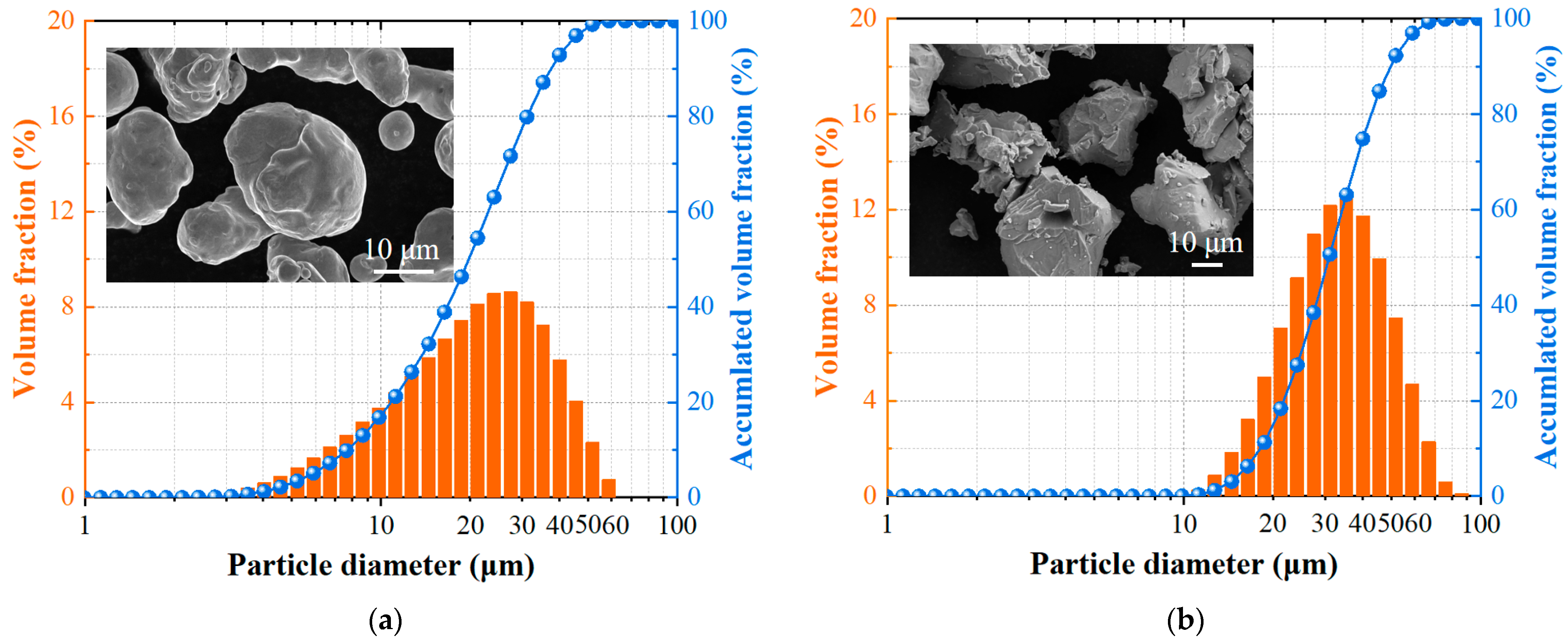

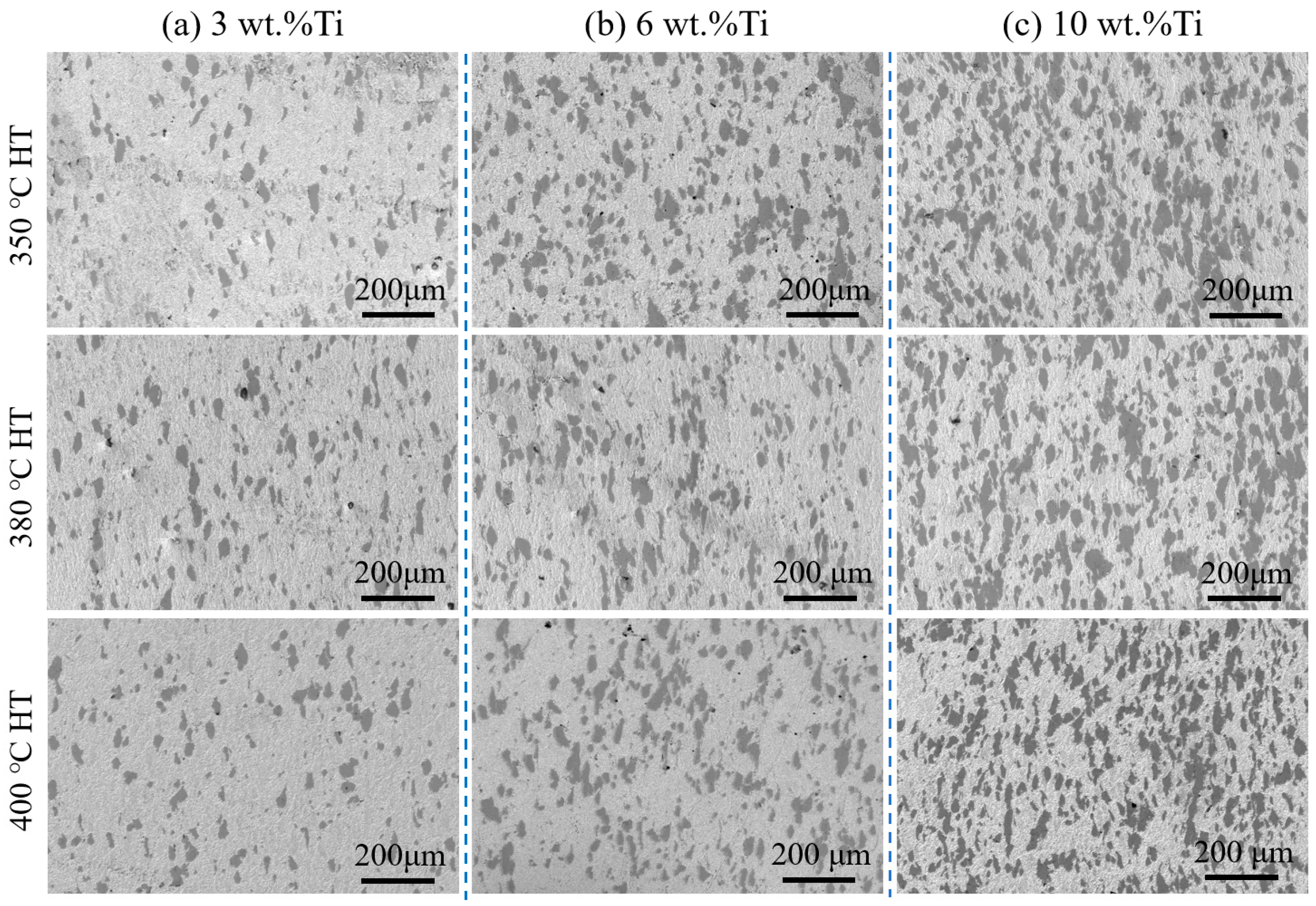
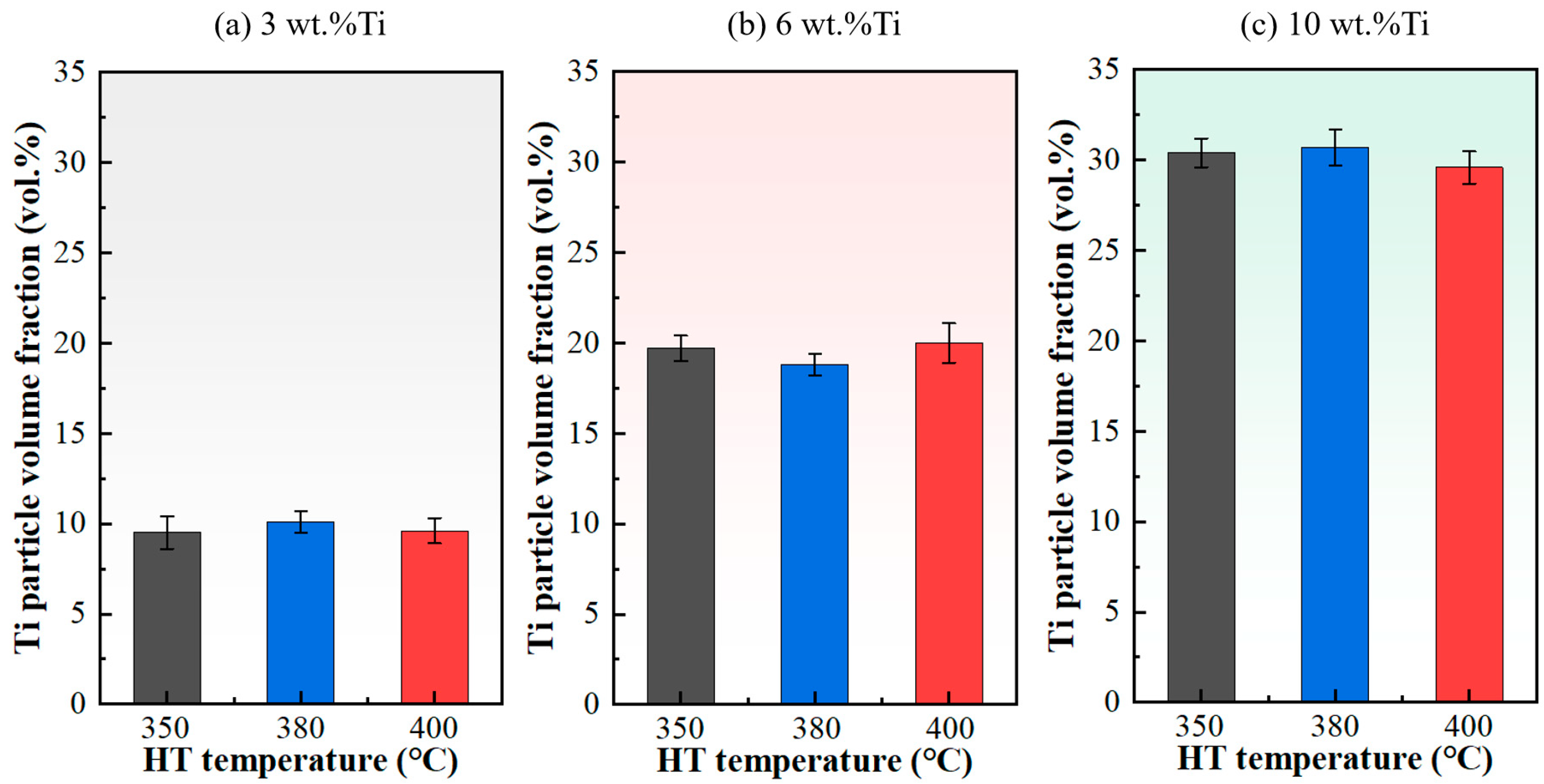

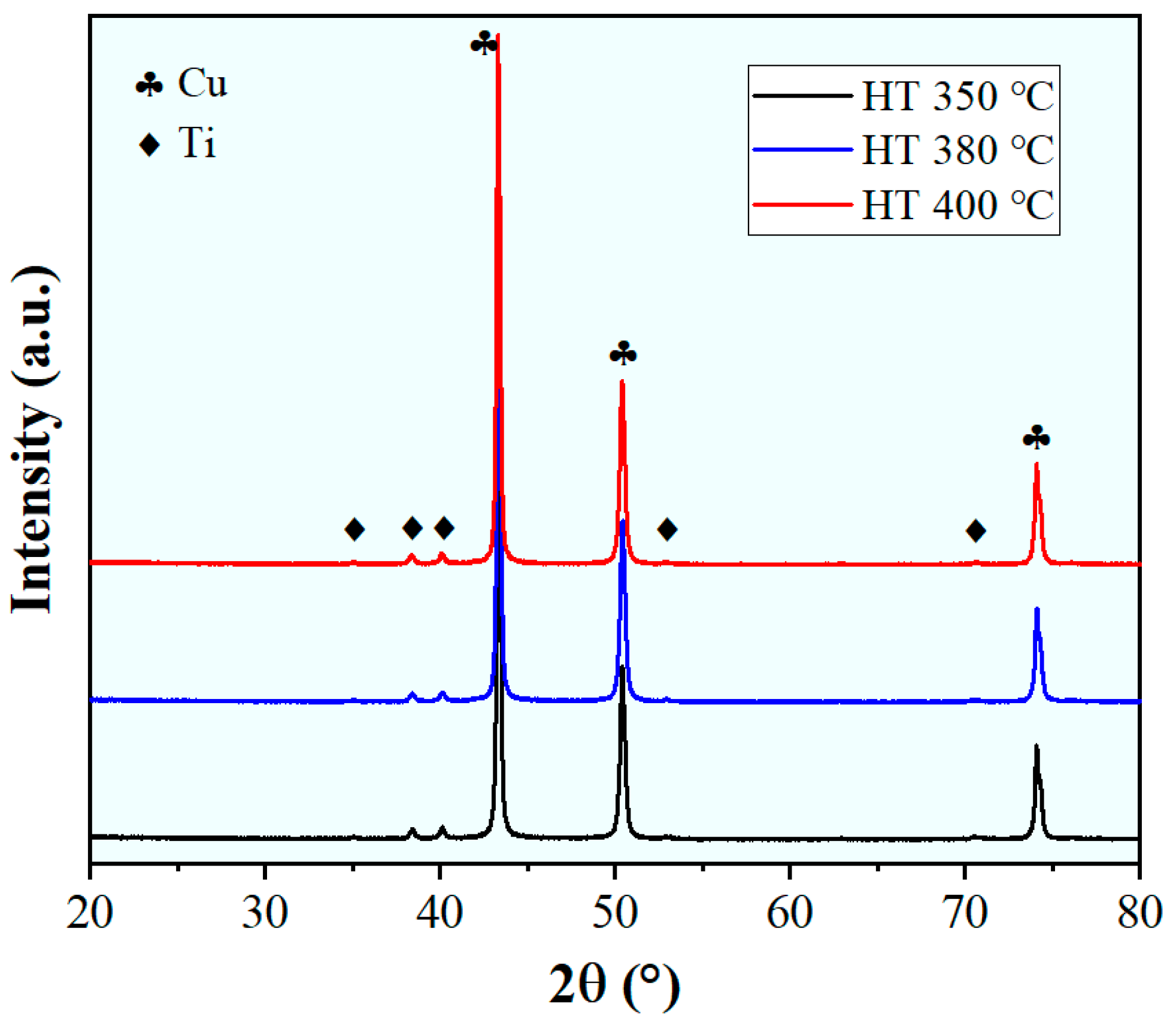
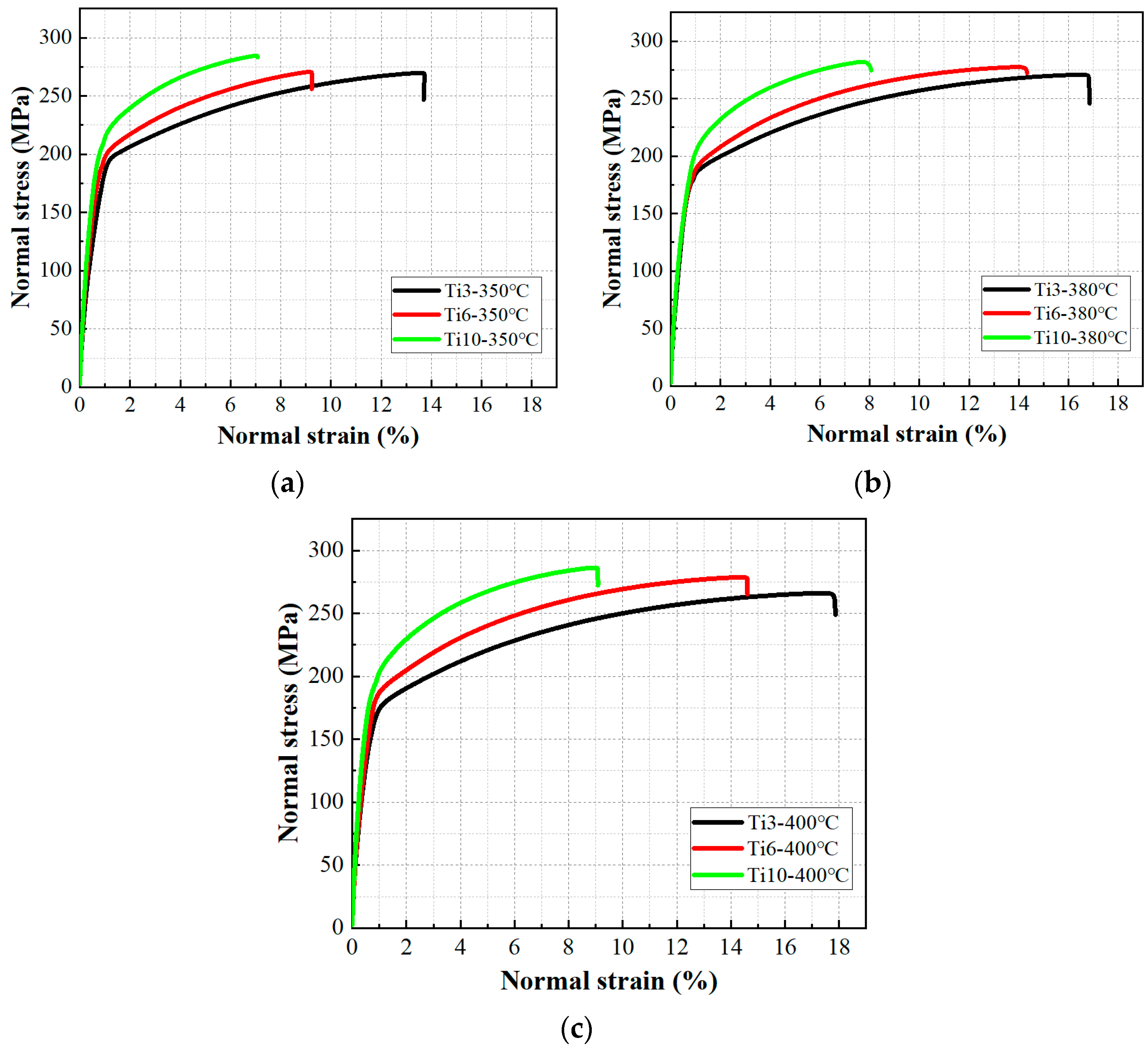
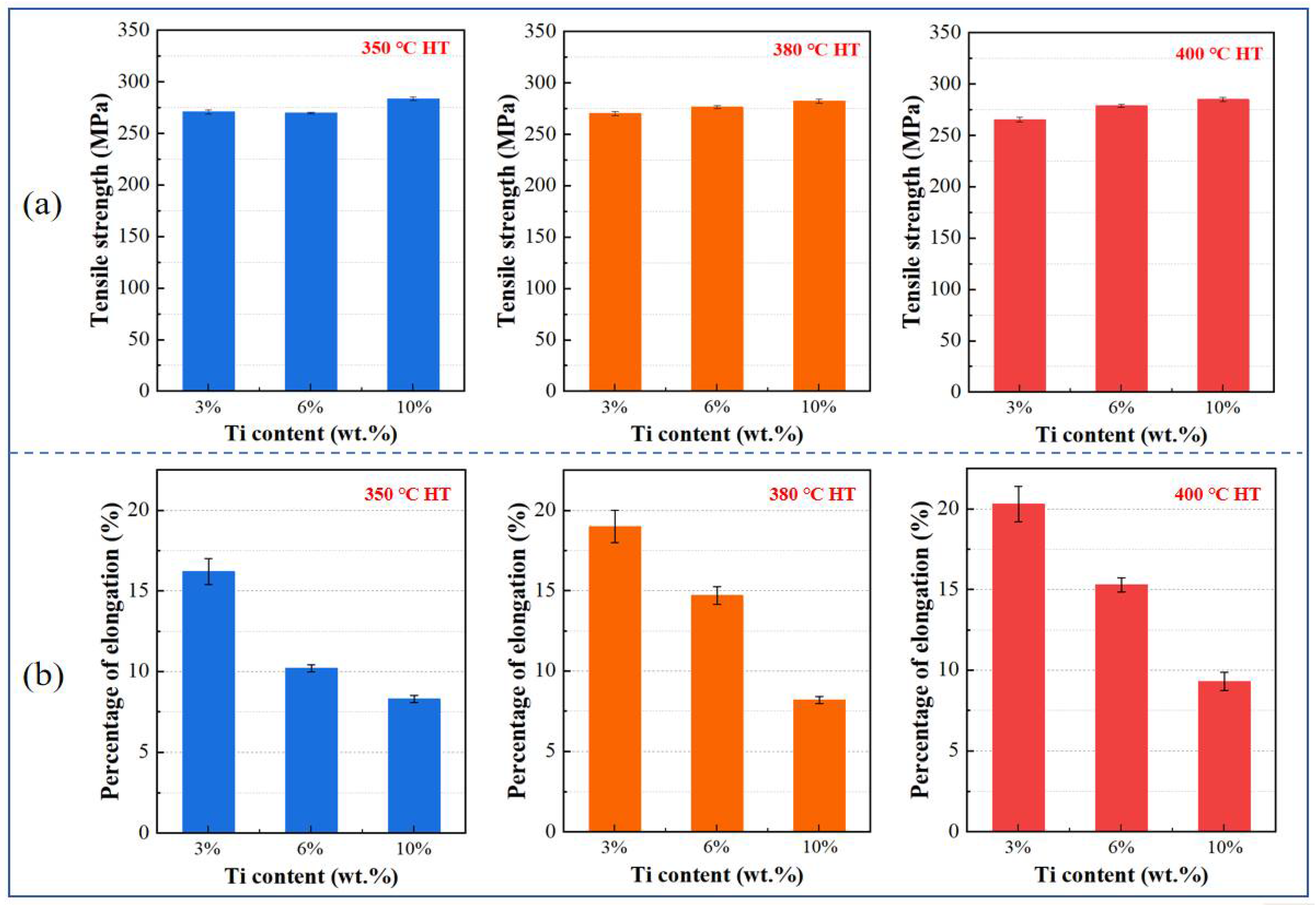
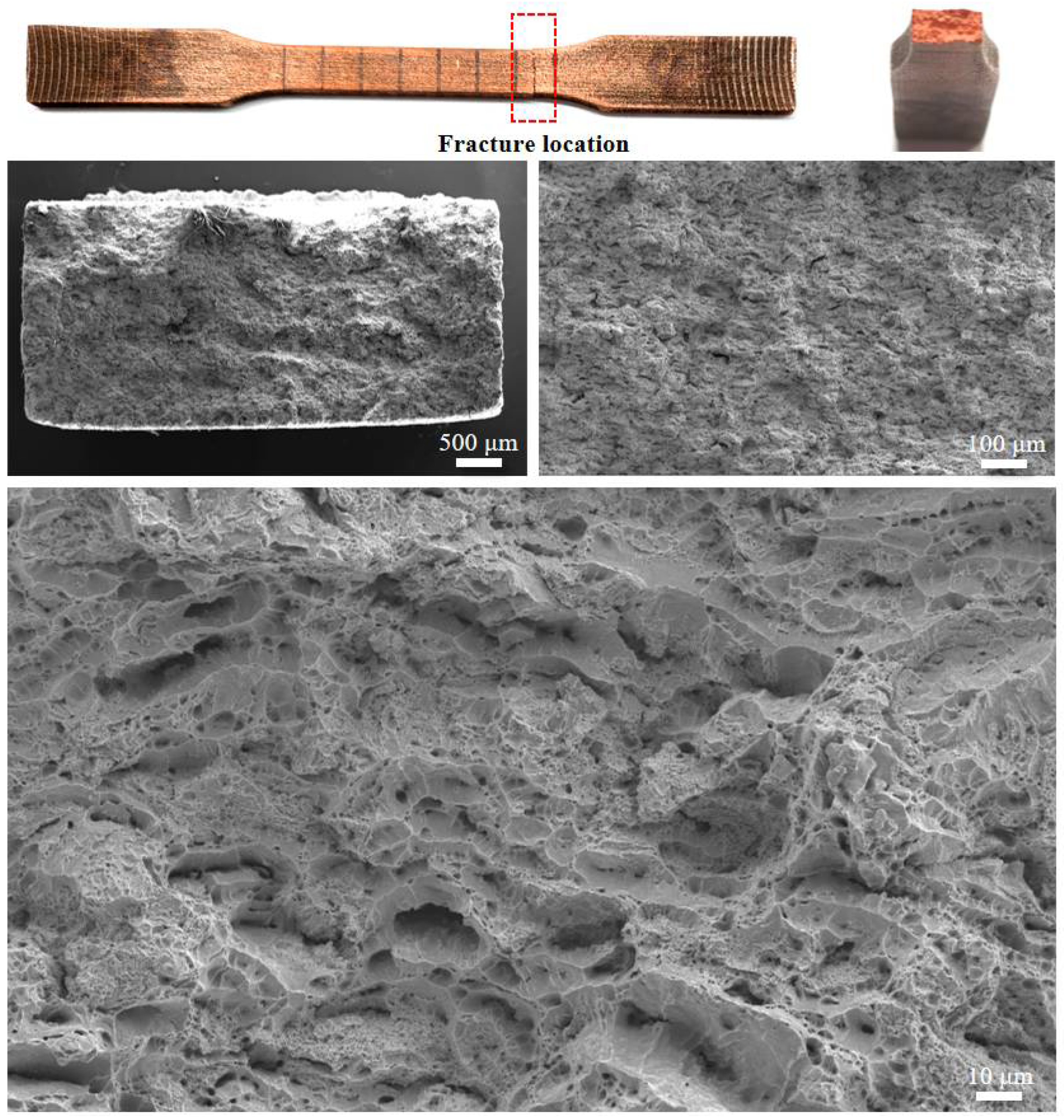


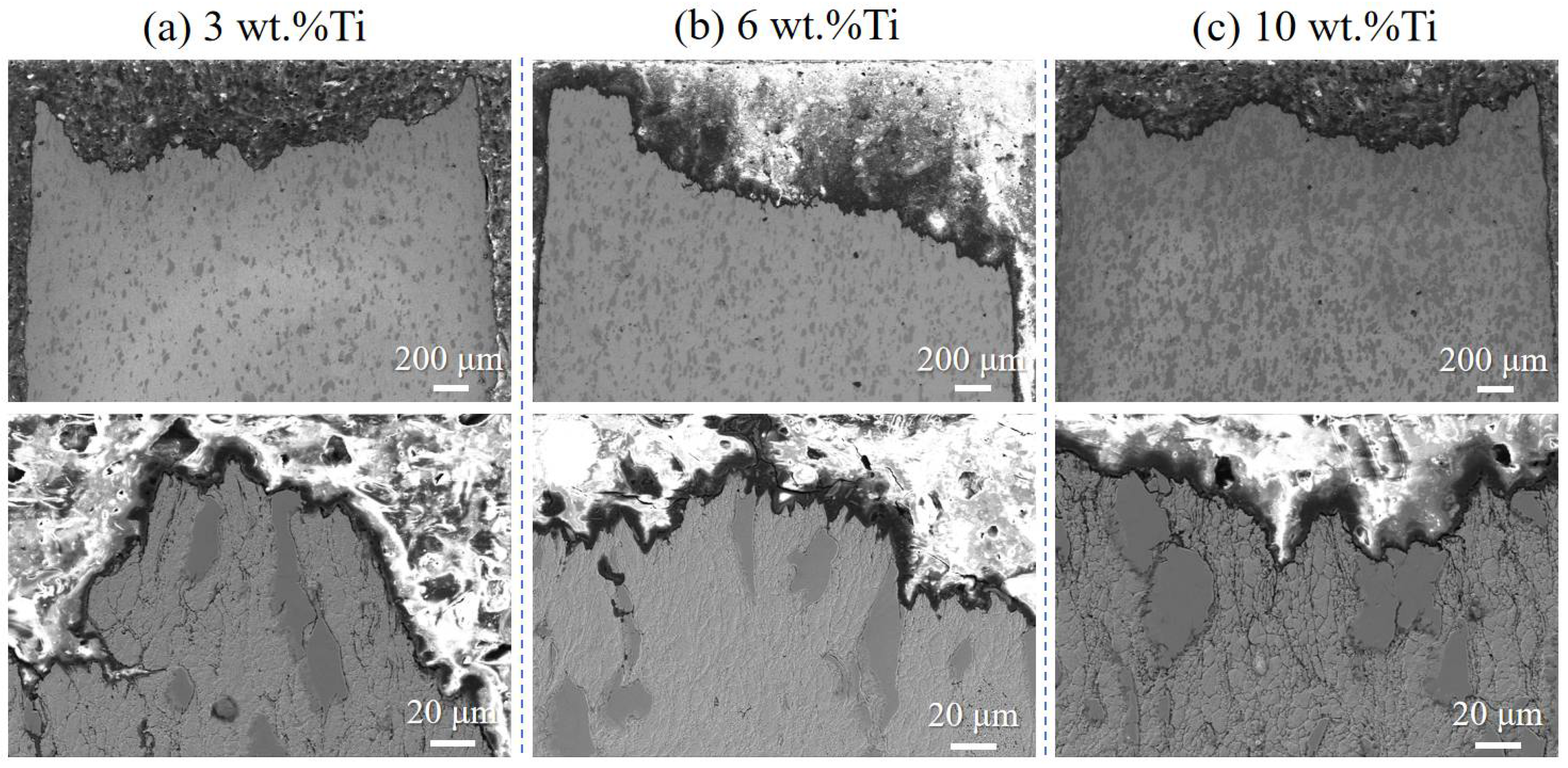


Disclaimer/Publisher’s Note: The statements, opinions and data contained in all publications are solely those of the individual author(s) and contributor(s) and not of MDPI and/or the editor(s). MDPI and/or the editor(s) disclaim responsibility for any injury to people or property resulting from any ideas, methods, instructions or products referred to in the content. |
© 2025 by the authors. Licensee MDPI, Basel, Switzerland. This article is an open access article distributed under the terms and conditions of the Creative Commons Attribution (CC BY) license (https://creativecommons.org/licenses/by/4.0/).
Share and Cite
Cheng, J.; Huang, J.; Li, H.; Zhang, K.; Chen, T.; Lan, H.; Huang, R. Influence of Titanium Content on the Microstructure and Tensile Behavior of Cold-Spray Additively Manufactured Copper-Titanium Composites. Materials 2025, 18, 5100. https://doi.org/10.3390/ma18225100
Cheng J, Huang J, Li H, Zhang K, Chen T, Lan H, Huang R. Influence of Titanium Content on the Microstructure and Tensile Behavior of Cold-Spray Additively Manufactured Copper-Titanium Composites. Materials. 2025; 18(22):5100. https://doi.org/10.3390/ma18225100
Chicago/Turabian StyleCheng, Jia, Jibo Huang, Haifan Li, Kejie Zhang, Tao Chen, Haiming Lan, and Renzhong Huang. 2025. "Influence of Titanium Content on the Microstructure and Tensile Behavior of Cold-Spray Additively Manufactured Copper-Titanium Composites" Materials 18, no. 22: 5100. https://doi.org/10.3390/ma18225100
APA StyleCheng, J., Huang, J., Li, H., Zhang, K., Chen, T., Lan, H., & Huang, R. (2025). Influence of Titanium Content on the Microstructure and Tensile Behavior of Cold-Spray Additively Manufactured Copper-Titanium Composites. Materials, 18(22), 5100. https://doi.org/10.3390/ma18225100



